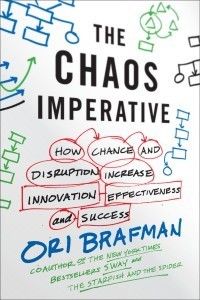Being Adaptive Means Cultivating A Little Chaos
by Rod Collins
There are fewer words that will strike utter fear in seasoned managers more than the word “chaos.” For most managers, chaos is, by definition, the absence of management. It’s what happens when managers lose control. It’s something to be avoided at all costs because its inevitable attributes of unpredictability and uncertainty are the mortal enemies of efficiency.
For the past century, the hallmark of management excellence has been efficiency. Thus, once a business achieves market dominance, management’s focus is all about sustaining its competitive advantage by cutting costs, eliminating variances, improving economies of scale. When efficiency is the principle preoccupation of management, stability is the ultimate state of effective management.
 But what happens when stability is not an option? What happens when the world is suddenly engulfed by a rapid pace of change and the most effective organizations are not necessarily the most efficient but rather the ones who are most adaptive? These were the questions that were on the mind of General Martin Dempsey when he reached out to Ori Brafman, after reading Brafman’s book The Starfish and the Spider, which described how leaderless organizations are oftentimes more adaptable than their centrally controlled counterparts.
But what happens when stability is not an option? What happens when the world is suddenly engulfed by a rapid pace of change and the most effective organizations are not necessarily the most efficient but rather the ones who are most adaptive? These were the questions that were on the mind of General Martin Dempsey when he reached out to Ori Brafman, after reading Brafman’s book The Starfish and the Spider, which described how leaderless organizations are oftentimes more adaptable than their centrally controlled counterparts.
The military, like most traditional organizations, believed efficiency was the pathway to excellence. However, given the realities of modern warfare, Dempsey was becoming increasingly aware that excellence on the battlefield had more to do with adaptability than efficiency. Like so many organizational leaders today, Dempsey was coming to terms with the realities of a rapidly changing world. In Dempsey’s first meeting with Brafman, the General related his concern that the army would need to change if its success depended upon its ability to quickly adapt. Dempsey recognized that imagination and innovation were the key ingredients of adaptability, and he was concerned that the army was deficient in both. When he asked Brafman what he needed to do to make the army more adaptive, the author’s response was a simple strategy: “Make the army more chaotic.”
An Unlikely Collaboration
In his latest book The Chaos Imperative, co-authored with Julian Pollack, Brafman relates the story of the unlikely collaboration between the career army general and the vegan Berkeley alumnus and how they used the power of chaos to increase the army’s excellence.
 Getting the army to embrace chaos as a resource was no easy task. According to Brafman, “We tend to confront chaos as if it were an unruly beast—something to be contained as much as possible.” However, in attempting to squelch chaos, leaders often inadvertently stifle the new ideas that are the seeds of innovation and the pathways to future growth. Dempsey knew the army needed better and quicker avenues to new ideas, so he was open to learning different—maybe even uncomfortable—ways of thinking and acting.
Getting the army to embrace chaos as a resource was no easy task. According to Brafman, “We tend to confront chaos as if it were an unruly beast—something to be contained as much as possible.” However, in attempting to squelch chaos, leaders often inadvertently stifle the new ideas that are the seeds of innovation and the pathways to future growth. Dempsey knew the army needed better and quicker avenues to new ideas, so he was open to learning different—maybe even uncomfortable—ways of thinking and acting.
An Emergent Process
In encouraging the army to become more chaotic, Brafman was not asking the soldiers to abandon all semblance of order, but rather to become proficient in a discipline he called “contained chaos.” While the notion that chaos can be managed in a disciplined way may sound counterintuitive, Brafman contends that “a little bit of chaos, encouraged but confined within borders, can be highly beneficial to an organization’s overall health.”
The discipline of “contained chaos” is an emergent process that involves three elements: white space, unusual suspects, and organized serendipity. White space is a time, place, or system unfettered by an established structure where people are free to self-organize, brainstorm, follow their imaginations, and make up their own rules. Interestingly, these are also the fundamental elements of “play.” Learning to value white space can be challenging for traditional organizational leaders who’ve come to believe that play is the antithesis of work. Nevertheless, a close look at today’s most well-run businesses reveals that their leaders understand that play is oftentimes a key component of work, which explains why Ping-Pong and pool tables have suddenly become standard office furniture in innovative companies. These amenities are not distractions from work, but rather the white space that spawns the emergence of new ideas.
The second element is the introduction of “unusual suspects.” These are outsiders who are not part of the usual group. These are the non-experts who don’t share the preconceived notions that make up the foundational knowledge of the experts. Experts, by definition, are those who know how things work and how things are done, given the current state of affairs. In a stabile world, their knowledge is paramount. However, in a rapidly changing world, expert understanding can become a treacherous obstacle to change. That’s because the effective response to change often requires us to be innovative and to come up with ways to do things differently or even to do different things. The essence of innovation is the connecting of unusual things, such as a telephone and the Internet. If you want to enable unusual connections, include unusual suspects when working to solve your most important problems.
The final element is organized serendipity. When there is sufficient white space and the inclusion of unusual suspects in the problem solving process, the circumstances are ripe for “new and creative ideas to emerge out of nowhere.” Brafman describes this attribute as the paradox of chaos. By cultivating a little chaos, leaders set the conditions for serendipity to happen. This entails creating “pockets of chaos,” where leaders don’t give directions, but rather facilitate creative group processes from which better quality directions emerge from the collaboration of people with very different perspectives. When leading organized serendipity, “structure and efficiency are set aside or blocked off to create a more organic process that allows new ideas to come to the fore.”
An Intelligence Advantage
In embracing Brafman’s advice to make the army more chaotic, General Dempsey and his soldiers have learned to become more adaptable. They have come to understand the limits of planning, the value of disruptive thinking, and the power of organized serendipity when faced with the challenges of unconventional warfare. By learning how to create white space, include unusual suspects, and facilitate organized serendipity, what has emerged are not only more adaptive and effective solutions but also the most important intelligence needed to succeed in rapidly changing environments: the knowledge of what they didn’t know that they didn’t know. When an organization has the wherewithal to effectively manage chaos and the capacity to uncover the “unknown unknowns” before taking action, they create for themselves a huge intelligence advantage, which in turn becomes both an adaptive and a competitive advantage in mastering a rapidly changing world.
Rod Collins (@collinsrod) is Director of Innovation at Optimity Advisors and author of Wiki Management: A Revolutionary New Model for a Rapidly Changing and Collaborative World (AMACOM Books, 2014).
Rod Collins's Blog
- Rod Collins's profile
- 2 followers




